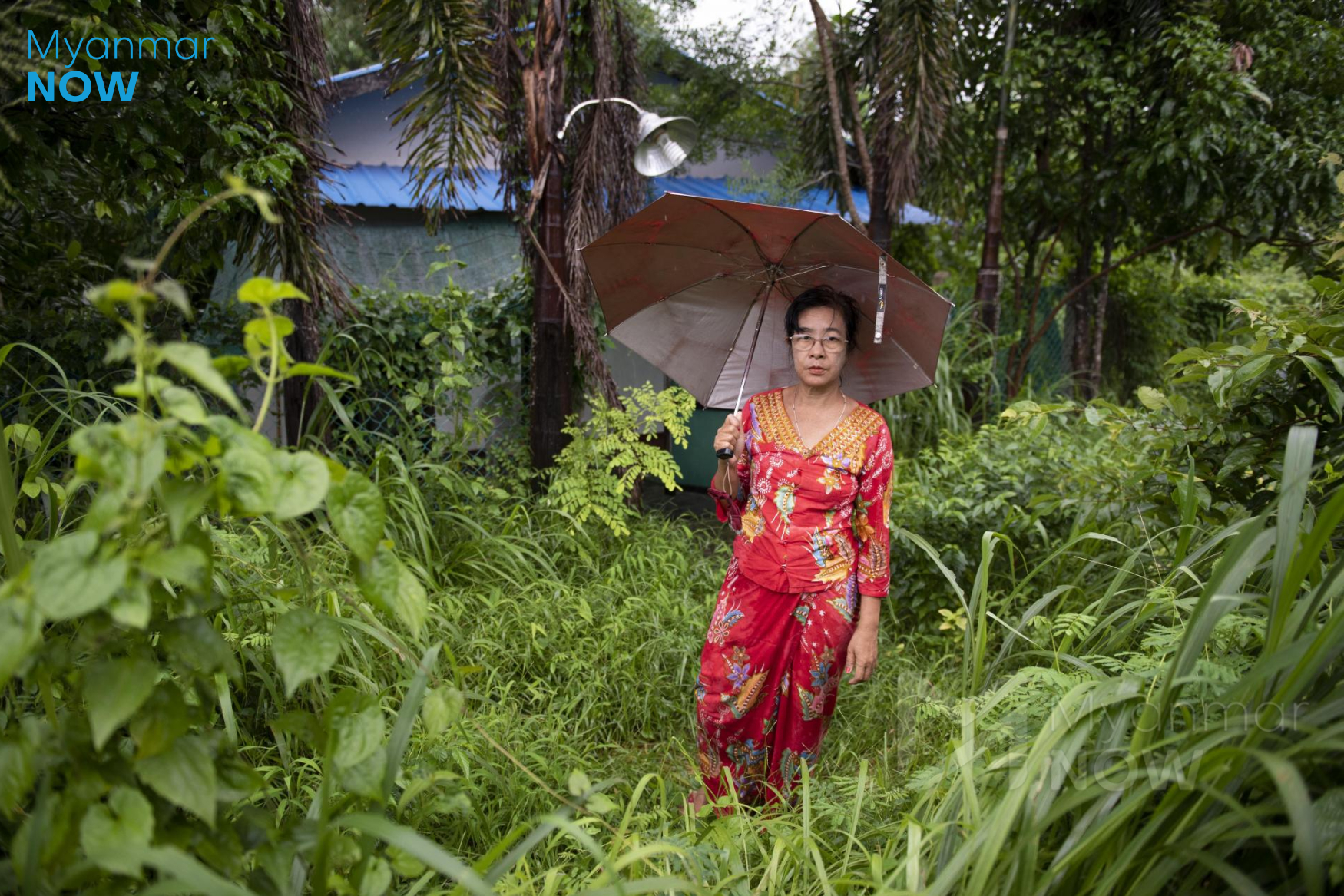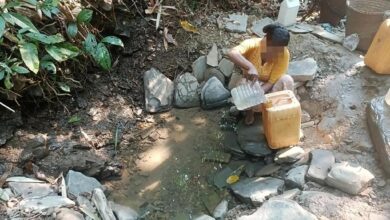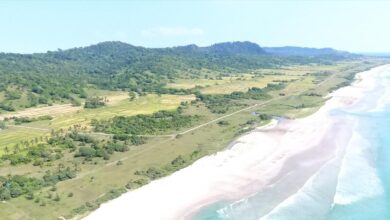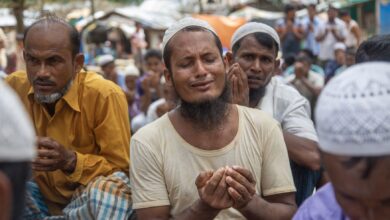
The sun had just risen as Ye Ye Nywe made her way home to her daughter, son-in-law and two grandsons one August morning in 2016, plodding along the dirt path that led to her house in Yangon’s northern outskirts.
As she approached, it seemed quiet inside the simple one-storey structure, which had a blue galvanised metal roof and stood alone amid bushy grass next to a copse of trees.
Ye Ye Nywe tried the front door, but it was locked from the inside. So she called out for the children, who were usually awake by now. “Han Thura!” she yelled. “Swan Htet Myat?”
When she heard nothing in reply, she went to the side of the house and peeked through the window into Swan Htet Myat’s bedroom. There she saw the eight-year-old lying dead in his bed, blood soaking his mosquito net and dripping into a pool on the floor.
Numb with shock, she fetched a group of neighbours. They entered the house through an open window to find everyone else dead too.
Her daughter’s husband, a former police officer named Soe Naung, was lying naked in the living room in a pool of blood, with deep stab wounds in his chest. At his feet was the body of 13-year-old Han Thura. Ye Ye Nywe’s daughter, Cherry Pwint, lay dead in the kitchen.
If Ye Ye Nywe, who is now 58, hadn’t spent the previous night away at her parents’ house, she would almost certainly have been murdered too.
More than four years since she arrived home to this nightmare, she is still searching for the truth about what happened.
‘Psychotic episode’
According to a statement released by the police ten months after their deaths, Soe Naung stabbed his wife and two children before killing himself.
“The forensic doctor confirmed the four horizontal stab wounds found on Soe Naung’s body were self-inflicted during a psychotic episode,” the June 2017 statement read.
“The deceased, Soe Naung, held a bachelor’s degree in philosophy, and had a quick-tempered nature,” it added. “He was known to carry weapons such as a baton and a dagger. The couple had marital problems… until the time of their death.”
Ye Ye Nywe and other relatives were appalled by the statement, and have pointed to several flaws in its logic. They also say Soe Naung was a loving and devoted father, not the violent, unstable man the police described.
Now, new evidence uncovered by Myanmar Now shows that police appear to have lied about the advice they received from the forensics expert — advice that contradicted their claim that Soe Naung was the killer.

Contrary to the police’s claim, Dr Nay Lwin Aye did not conclude that Soe Naung had killed himself; his professional opinion was the exact opposite.
Soe Naung “was stabbed in two fatal areas,” the doctor told Myanmar Now in an interview at his office in Insein General Hospital in August. “One on the right side and the other on the left side. It is impossible for him to stab the area on his right after stabbing the fatal area on his left.”
“You can say my observations did not agree with the police statement,” he said.
Dr Nay Lwin Aye has never been summoned to testify about the cause of Soe Naung’s death in court because the case never made it that far. In fact, the police appear to have made no effort to move the case forward after claiming it was a murder-suicide in 2017.
The police ruled out the possibility that the family were killed in a robbery because there were no signs of forced entry. Cherry Pwint was still wearing her diamond earrings when she was found and 105,000 kyat ($90) in cash had been left untouched in the house. There was also no DNA evidence to suggest an intruder had been present, police claimed.
But they never explained how they ruled out the possibility that the killings were premeditated, despite the fact there is evidence to support this theory.

‘Things are too dangerous here’
The police statement failed to mention that shortly before his death, Soe Naung told his older brother that he was in danger, and that he planned to leave Yangon with his family.
Soe Naung’s brother is a monk named Sayadaw U Wisarya, who lives in a monastery 15 miles from the house where the family were killed. On the morning of August 19, 2016, Soe Naung invited Wisarya to have lunch at his house.
As they ate, the monk thought his brother seemed uneasy, and asked him if everything was okay. Soe Naung answered that he and his family were in danger but wouldn’t go into any details, Wisarya recalls.
“He sent me off. I left his house between 1:30pm and 2pm. We chatted for a while after lunch. They took me to the bus stop on his motorcycle,” he said.
Shortly before 6pm, after Wisarya had returned to the monastery, Soe Naung called him on the phone and said he and his family were going to move to the brothers’ childhood village in Madauk township, about 150km northeast of Yangon.
“He told me he felt unsafe and was being threatened. He talked about his plan to sell the house and relocate,” Wisarya said.
“I asked why and he said because things were too dangerous. He was having some problems.”
After leaving the police force, Soe Naung set up a small construction business. Shortly before the call with Wisarya, he had won a contract to build concrete pathways in his neighbourhood. Other business owners who had put in bids to build the lanes were unhappy he had won, he told Wisarya.
“He said his competitors were attacking him out of jealousy,” Wisarya said.
The police knew about this when investigating the killings; they had obtained a 30-minute recording of the phone conversation between Soe Naung and Wisarya from the phone company.

It appears police did not pursue this lead. Their statement makes no mention of the fact Soe Naung told his brother he was facing threats from business competitors. And it is unclear if police ever found or questioned the competitors.
In the phone recording, which Myanmar Now listened to at Yangon Regional Police Headquarters, Soe Naung told his brother that he was worried his sons’ education would suffer when the family moved home.
Hours later, he and his family were dead.
“I guess he was facing a serious and imminent threat,” said Wisarya during an interview at the old wooden monastery where he lives in South Dagon. “I was very surprised when he said he wanted to move back to the village. He had never talked about going back to the village, not even once.”
“If I had known, I would have brought them to my monastery. I could have died too, but I don’t really mind. I would have brought them here if I had known,” he added.
Three days before her death, Cherry Pwint, or somebody using her phone, took pictures of three unknown men who were lurking around the outside of the family home and taking photos.
There are few other houses in the area, which is mostly grassland, so it was especially suspicious that the men showed up without announcing themselves and appeared to inspect the perimeter of the fence around the house, said Ye Ye Nywe.
The police said in their statement they had been unable to identify the three men. They did not specify how they were nonetheless able to rule out the possibility that the men were involved in the killings.
‘He loved his sons that much’
Soe Naung became a police officer immediately after finishing high school in 1996. His father was a former member of a military-backed local militia unit in Bago, and was proud of his son for joining the force, Wisarya said.
Soe Naung “was never violent. He had never been in a fight, and he was never punished by the teachers at school,” Wisarya said.
After joining the police force, Soe Naung studied philosophy through a distance learning course at Dagon University. He later moved to Insein township, where he met and married Cherry Pwint.
Ye Ye Nywe said her son-in-law devoted his life to his family.
“He took the kids to school every morning. He bathed them. I ground sandalwood for them, and he would apply the sandalwood paste to the children’s cheeks. He loved his sons that much. He used to take photos of his sons, and immediately print them at the shop,” she said.

He seemed equally devoted to his career. He was promoted from a regular police officer to a sub-inspector, Wisarya said, and served in a unit called the Number 8 Riot Security Police Force for many years before his resignation.
As a member of that unit, he took part in a major drug bust, Wisarya said. In 2012 he was awarded a certificate of excellence signed by former President Thein Sein, which was still hanging on his living room wall when he was found dead. It is unclear if the certificate was awarded because of the drug bust.
Myanmar Now was unable to independently verify Wisarya’s statements about the drug bust because police officials would not answer questions about Soe Naung’s police career.
Despite his apparent success, Soe Naung mysteriously resigned from the force in 2014, aged 35. He never gave his family an explanation for the decision.
He began working in real estate and selling construction materials wholesale, and bought a 45 by 25 foot plot of land in Yangon’s Mingaladon township, where he built the house with the blue roof.
Wisarya didn’t learn about Soe Naung’s resignation until a year later, he said, although the two brothers were in regular contact.
Then, after his brother’s death, Wisarya heard that Soe Naung had been passed over for a promotion after helping in the drug trafficking case. Wisarya also said that the case against the traffickers had been quietly dismissed, but was unable to offer further details.
Witchcraft and ghosts
Several other aspects of the police’s statement raise questions about its veracity. It mentions, for example, that Soe Naung was known to own a baton and a dagger, and yet it fails to mention that he owned these weapons because he was a former police officer. The statement did not acknowledge his police career at all.
Wisarya feels this was part of an attempt to unfairly portray his brother as violent and unstable.
“The police taught him to carry weapons,” he said. “How can a police officer be a police officer if he cannot use a baton or a dagger? I think you cannot blame a police officer for carrying weapons. I could accept the statement if he had been a civilian.”
The statement mentioned that the family had books on “witchcraft, ghosts and spirits” and that they practiced Yadaya, magical rituals aimed at averting misfortune.
The name of a person the family owed money to was written in ink on the soles of Cherry Pwint’s feet when her body was found, the statement noted.
Ye Ye Nywe feels the reference to witchcraft was an attempt to make Soe Naung seem unhinged and dangerous. But in truth, she says, the books on magic that the police found belonged to her.
The most glaring flaw in the police’s statement, though, is its treatment of the forensic evidence.

The forensic report, acquired by Myanmar Now, said a 7-inch dagger was found near Soe Naung’s left hand. The police argued that this was the murder weapon he used to stab his three family members and then himself. A bruise on Soe Naung’s left little finger showed that he had been gripping the dagger tightly, the police statement said.
But Dr Nay Lwin Aye, the forensic doctor who examined the family’s bodies, did not feel the bruise in Soe Naung’s finger was sufficient to conclude murder-suicide.
The stab wounds Soe Naung suffered are “rarely found in suicide cases” and given that he had several, two of which were instantly fatal, “it is impossible” that he killed himself, the doctor said.
“But they asked me if Soe Naung committed suicide,” he added. “Not the two children and his wife. They only asked me about Soe Naung’s injuries, and I answered that these types of injuries are rarely caused by self-stabbing. The police concluded he murdered his younger son first, and then killed his elder son and wife before committing suicide.”
Another forensic doctor, who reviewed the forensic report on behalf of Myanmar Now but asked to remain anonymous, said he supported Dr Nay Lwin Aye’s conclusion.
“If these were self-inflicted injuries, at least one of the stab wounds would be less deep because the stabbing force would be reduced during the subsequent stabs,” he said.
“The length and depth of his wounds were not that different. Police concluded he stabbed himself after stabbing his kids and wife, but all the wounds were caused by an equal amount of force and had equal depth and length. If he committed suicide, why were all his stab wounds the same depth?” he added.
After they heard news of the killings, the team of forensic doctors at North Okkalapa Hospital, which was closest to the crime scene, were expecting to receive the bodies, the forensic doctor added. The team at Yangon General Hospital, which is further away but has more forensic experts, thought they might also be asked to examine them, he added.
He said he does not understand why the bodies were taken instead to Insein Hospital, where only Dr Nay Lwin Aye was on duty.
“The case was unusual and complicated. The victim was a [former] police officer,” he said. “His body should have been taken to either North Okkalapa Hospital in Mingaladon or Yangon General Hospital. Many forensic doctors there would have come up with different observations. Many cases from all over the country are referred to Yangon General Hospital.”
The police statement said that “the forensic doctor examined the bruise on the little finger of Soe Naung’s left hand, and confirmed the bruise was the result of gripping the metal hilt of the dagger tightly and stabbing multiple times.”
“The finding confirmed the deceased Soe Naung was left-handed,” it added.
Both Ye Ye Nywe and Wisarya are adamant that Soe Naung was right-handed. They provided Myanmar Now with multiple family photos showing him using his right hand.
Ye Ye Nywe also showed these photos to the police during the investigation, she said.
“He was not left-handed,” she said. “We had been living together since their wedding. I have never seen him using his left hand. He always used his right hand.”
Myanmar Now approached the Myanmar Police Force numerous times for comment about Soe Naung’s case. A police colonel named Kyaw Thiha, who works as a spokesperson, failed to respond to several requests for information.
Only when Myanmar Now told him it was about to publish details of the case that police had failed to address in their statement did he reply to say that police are still investigating. He did not offer any evidence to support this claim.

‘Pull me with the wind’
After her home was turned into a slaughterhouse in 2016, Ye Ye Nywe moved out and went to live in Hlegu with her son, who is a police officer.
Over the past four years, she has taken the bus several times to Insein township — usually dressed in her red floral longyi and carrying her things in a plastic basket — to visit the police station and ask if there has been any progress on the case.
Every time she does so, she is told the investigating officer is not at his desk and sent away. When that happens she walks to the Mingaladon court to ask if they are handling the case yet. The answer is always no, and the court officers on duty tell her to ask at the police station.
So she has been forced to look elsewhere for answers. Once or twice a month, she returns to the house with the blue roof, wading through overgrown grass to reach the door. She spends several nights there sleeping alone, she said, in the hope that her dead relatives will visit her in her dreams and tell her who killed them.
“When the wind blew I asked if it was my grandchildren,” she said, recalling one such visit as she wiped away tears.
“I asked them to pull me. I said ‘pull grandma’. I asked my daughter to pull me too, to give me a sign. I begged Soe Naung to help me solve the case. I asked them to visit me in my dream. It never happened.”
(Editing by Joshua Carroll)



